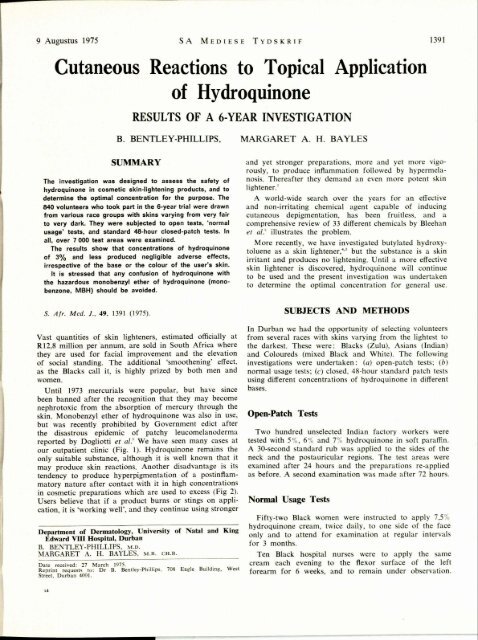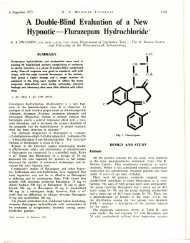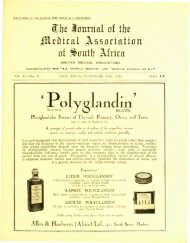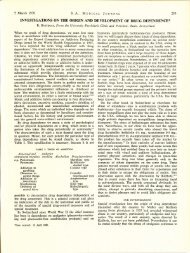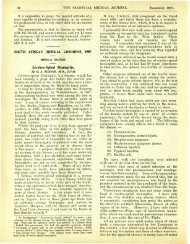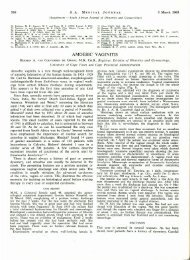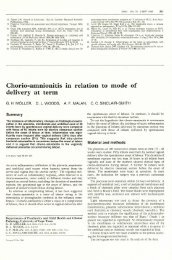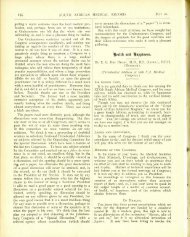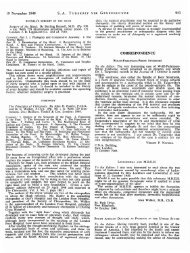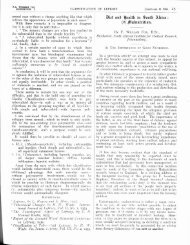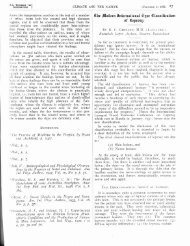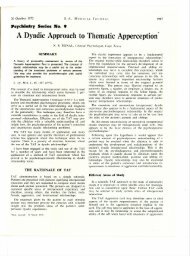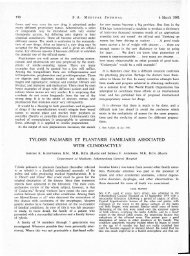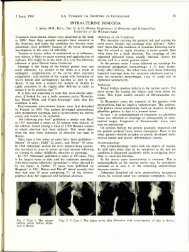Cutaneous Reactions to Topical Application of Hydroquinone
Cutaneous Reactions to Topical Application of Hydroquinone
Cutaneous Reactions to Topical Application of Hydroquinone
You also want an ePaper? Increase the reach of your titles
YUMPU automatically turns print PDFs into web optimized ePapers that Google loves.
9 Augustus 1975 SA MEDIESE TYDSKRIF 1391<br />
<strong>Cutaneous</strong> <strong>Reactions</strong> <strong>to</strong> <strong>Topical</strong> <strong>Application</strong><br />
<strong>of</strong> <strong>Hydroquinone</strong><br />
RESULTS OF A 6-YEAR INVESTIGATION<br />
B. BENTLEY-PHILLIPS,<br />
SUMMARY<br />
The investigation was designed <strong>to</strong> assess the safety <strong>of</strong><br />
hydroquinone in cosmetic skin-lightening products, and <strong>to</strong><br />
determine the optimal concentration f.or the purpose. The<br />
840 volunteers who <strong>to</strong>ok part in the 6-year trial were drawn<br />
from various race groups with skins varying from very fair<br />
<strong>to</strong> very dark. They were subjected <strong>to</strong> open tests, 'normal<br />
usage' tests, and standard 48-hour closed-patch tests. In<br />
all, over 7000 test areas were examined.<br />
The results show that concentrations <strong>of</strong> hydroquinone<br />
<strong>of</strong> 3% and less produced negligible adverse effects,<br />
irrespective <strong>of</strong> the base or the colour <strong>of</strong> the user's skin.<br />
It is stressed that any confusion <strong>of</strong> hydroquinone with<br />
the hazardous monobenzyl ether <strong>of</strong> hydroquinone (monobenzone,<br />
MBH) should be avoided.<br />
S. Afr. Med. l., 49, 1391 (1975).<br />
Vast quantIties <strong>of</strong> skin lighteners, estimated <strong>of</strong>ficially at<br />
R12,8 million per annum, are sold in South Africa where<br />
they are used for facial improvement and the elevation<br />
<strong>of</strong> social standing. The additional 'smoothening' effect,<br />
as the Blacks call it, is highly prized by both men and<br />
women.<br />
Until 1973 mercurials were popular, but have since<br />
been banned after the recognition that they may become<br />
nephro<strong>to</strong>xic from the absorption <strong>of</strong> mercury through the<br />
skin. Monobenzyl ether <strong>of</strong> hydroquinone was also in use,<br />
but was recently prohibited by Government edict after<br />
the disastrous epidemic <strong>of</strong> patchy leucomelanoderma<br />
reported by Dogliotti et al.' We have seen many cases at<br />
our outpatient clinic (Fig. 1). <strong>Hydroquinone</strong> remains the<br />
only suitable substance, although it is well known that it<br />
may produce skin reactions. Another disadvantage is its<br />
tendency <strong>to</strong> produce hyperpigmentation <strong>of</strong> a postinflamma<strong>to</strong>ry<br />
nature after contact with it in high concentrations<br />
in cosmetic preparations which are used <strong>to</strong> excess (Fig 2).<br />
Users believe that if a product bums or stings on application,<br />
it is 'working well', and they continue using stronger<br />
Department <strong>of</strong> Derma<strong>to</strong>logy, University <strong>of</strong> Tatal and King<br />
Edward VID Hospital, Durban<br />
B. BENTLEY-PHILLIPS, M.D.<br />
MARGARET A. H. BAYLES, M.B. CH.B.<br />
Date received: 27 March 1975.<br />
Reprint request< 10: Dr B. Bentley-Phillips. 708 Eagle Building, West<br />
Street, Durban 4001.<br />
14<br />
MARGARET A. H. BAYLES<br />
and yet stronger preparations, more and yet more vigorously,<br />
<strong>to</strong> produce inflammation followed by hypermelanosis.<br />
Thereafter they demand an even more potent skin<br />
lightener.'<br />
A world-wide search over the years for an effective<br />
and non-irritating chemical agent capable <strong>of</strong> inducing<br />
cutaneous depigmentation, has been fruitless, and a<br />
comprehensive review <strong>of</strong> 33 different chemicals by Bleehan<br />
et al.' illustrates the problem.<br />
More recently, we have investigated butylated hydroxy<strong>to</strong>luene<br />
as a skin lightener:,5 but the substance is a skin<br />
irritant and produces no lightening. Until a more effective<br />
skin lightener is discovered, hydroquinone will continue<br />
<strong>to</strong> be used and the present investigation was undertaken<br />
<strong>to</strong> determine the optimal concentration for general use.<br />
SUBJECTS AND METHODS<br />
In Durban we had the opportunity <strong>of</strong> selecting volunteers<br />
from several races with skins varying from the lightest <strong>to</strong><br />
the darkest. These were: Blacks (Zulu), Asians (Indian)<br />
and Coloureds (mixed Black and White). The following<br />
investigations were undertaken: (a) open-patch tests; (b)<br />
normal usage tests; (c) closed, 48-hour standard patch tests<br />
using different concentrations <strong>of</strong> hydroquinone in different<br />
bases.<br />
Open-Patch Tests<br />
Two hundred unselected Indian fac<strong>to</strong>ry workers were<br />
tested with 5%, 6% and 7% hydroquinone in s<strong>of</strong>t paraffin.<br />
A 30-second standard rub was applied <strong>to</strong> the sides <strong>of</strong> the<br />
neck and the postauricular regions. The test areas were<br />
examined after 24 hours and the preparations re-applied<br />
as before. A second examination was made after 72 hours.<br />
Normal Usage Tests<br />
Fifty-two Black women were instructed <strong>to</strong> apply 7,5%<br />
hydroquinone cream, twice daily, <strong>to</strong> one side <strong>of</strong> the face<br />
only and <strong>to</strong> attend for examination at regular intervals<br />
for 3 months.<br />
Ten Black hospital nurses were <strong>to</strong> apply the same<br />
cream each evening <strong>to</strong> the flexor surface <strong>of</strong> the left<br />
forearm for 6 weeks, and <strong>to</strong> remain under observation.
1394 SA MEDICAL JOURNAL 9 August 1975<br />
TABLE Ill. PERCENTAGE POSITIVE REACTIONS AT 48 HOURS TO HYDROQUINONE CREAMS AND LOTIONS IN 256<br />
BLACK FEMALES<br />
Concentration<br />
<strong>of</strong><br />
hydroquinone<br />
C%)<br />
1<br />
2,5<br />
3,5<br />
5,0<br />
7,0<br />
Closed 48-Hour Patch Tests<br />
Cream<br />
Number treated % pos.<br />
100 1<br />
100 1<br />
166 10,8<br />
206 25,7<br />
140 35,0<br />
Table Il shows the results <strong>of</strong> testing the various<br />
concentrations <strong>of</strong> hydroquinone on 578 volunteers drawn<br />
from the different racial groups. Table III demonstrates<br />
the different reactions <strong>to</strong> creams and lotions containing<br />
the same concentrations <strong>of</strong> hydroquinone.<br />
DISCUSSION<br />
Because hydroquinone is the only effective skin lightener<br />
available in South Africa, we considered that an attempt<br />
should be made <strong>to</strong> determine the optimal concentration<br />
for use in cosmetics. Preparations on sale have a content<br />
<strong>of</strong> hydroquinone between I % and 7,5"b in various bases<br />
and it was anticipated that the higher the concentration<br />
the more likely would be adverse reactions. Table II<br />
clearly demonstrates this point and even allowing for<br />
the severity <strong>of</strong> a 48-hour closed-patch test, it was thought<br />
that a high content <strong>of</strong> hydroquinone should be avoided<br />
and that about 3°{, is the optimal amount for all pigmented<br />
skins.<br />
<strong>Hydroquinone</strong> is regarded as a mild primary irritant and<br />
likely <strong>to</strong> produce a sensitivity and a contact dermatitis in<br />
those previously exposed <strong>to</strong> it. This probably accounts<br />
for the big difference in response <strong>of</strong> the various races<br />
<strong>to</strong> closed-patch tests (Table 11). Indians are usually content<br />
with the colour <strong>of</strong> their skin, but the other races are<br />
not and, consequently, large numbers <strong>of</strong> Blacks and<br />
Coloureds would have been sensitised prior <strong>to</strong> our testing.<br />
We were unable <strong>to</strong> assess the effects <strong>of</strong> hydroquinone on<br />
Whites, who generally prefer bronzed <strong>to</strong> pale faces.<br />
Only I White patient with contact dermatitis from skin<br />
lighteners has been seen during the past 7 years. This was<br />
an 82-year-old English woman who had preserved her<br />
lily-white complexion for over 50 years with a mercurial<br />
preparation without ill effect until, without her knowledge,<br />
the formula was altered and MBH substituted for the<br />
mercury. Within a month she developed a typical MBH<br />
leucomelanoderma.<br />
A salutary lesson needs <strong>to</strong> be learned from Fitzpatrick<br />
et al.,' who in 1966 detailed the chemistry and the entirely<br />
different modes <strong>of</strong> action <strong>of</strong> hydroquinone and MBH and<br />
pointed out that the 'confetti-like depigmentation' which<br />
develops frequently with MBH, had never been observed<br />
with hydroquinone.<br />
Number treated<br />
Nil<br />
116<br />
66<br />
116<br />
Nil<br />
Lotion<br />
';10 pos.<br />
Preparation not available<br />
0,9<br />
1,5<br />
15,5<br />
Preparation not available<br />
Had all the manufacturers <strong>of</strong> cosmetics been aware <strong>of</strong><br />
this, the recent disastrous epidemic <strong>of</strong> leucomelanoderma<br />
could have been prevented by banning MBH years ago.<br />
Bases also make a difference and the figures shown in<br />
Table III illustrate this point. In the Black women tested<br />
it was clear that the 3,5% and 5% creams produce<br />
considerably more reactions than lotions <strong>of</strong> the same<br />
strength. No significant difference was observed between<br />
creams and lotions containing 2,5% hydroquinone, or less.<br />
In all cases, adequate control patches were applied and·<br />
all the ingredients constituting the bases <strong>of</strong> creams and<br />
lotions were exonerated· from any irritant effects by<br />
48-hour patch tests, as previously mentioned.<br />
Hyperpigmentary reactions <strong>of</strong> a delayed type without<br />
preceding erythema, and contact-type erythema progressing<br />
<strong>to</strong> hyperpigmentation, were the most frequently seen<br />
adverse effects. The latter was obviously a postinflamma<strong>to</strong>ry<br />
type <strong>of</strong> hyperpigmentation seen frequently in our hospital<br />
outpatient department. The former, however, might be<br />
explained by the binding <strong>of</strong> hydroquinone <strong>to</strong> keratin and<br />
the subsequent oxidation <strong>to</strong> a brown tint, as described<br />
by Fitzpatrick et al." Without further applications, both<br />
types <strong>of</strong> hyperpigmentation disappear gradually.<br />
CONCLUSIONS<br />
Firstly, from these investigations it is evident that hydroquinone<br />
is a suitable substance for incorporation in<br />
cosmetics designed for skin lightening, if the content is<br />
kept below a certain limit. We conclude that 3% hydroquinone<br />
is the optimal strength, irrespective <strong>of</strong> the base<br />
used or the colour <strong>of</strong> the user's skin.<br />
Secondly, from our clinical observations there is an<br />
impression that most <strong>of</strong> the adverse effects occur from<br />
misuse, excessive use and the application <strong>of</strong> multiple<br />
preparations. In order <strong>to</strong> prevent these harmful practices<br />
it is imperative for manufacturers <strong>to</strong> enclose a suitably<br />
worded warning in each pack.<br />
Finally, in order <strong>to</strong> prevent harm, it is essential that<br />
manufacturers and medical practitioners be aware <strong>of</strong> the<br />
difference between hydroquinone itself, and the. monobenzyl<br />
ether <strong>of</strong> hydroquinone. This is <strong>of</strong> paramount<br />
importance, since MBH may be used either illegally or<br />
ignorantly in countries where skin lighteners are in vogue.


